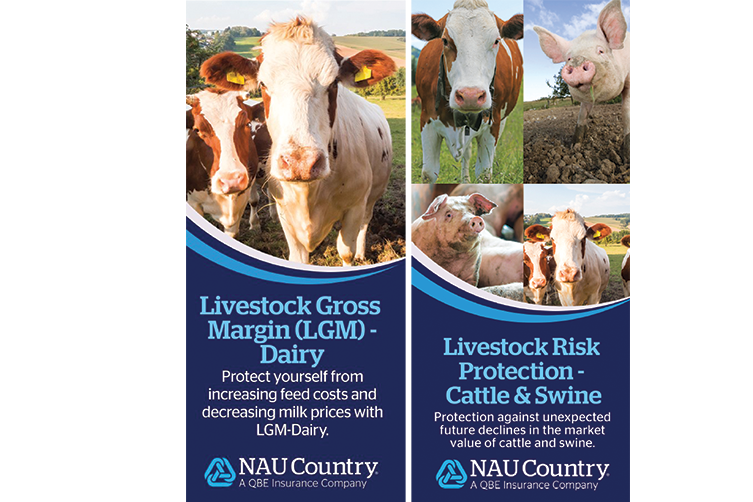Unlocking Growth Potential: Bagley Risk Management Approaches
Unlocking Growth Potential: Bagley Risk Management Approaches
Blog Article
Key Elements to Think About When Deciding On Animals Danger Defense (LRP) Insurance
When reviewing choices for Animals Danger Defense (LRP) insurance, numerous key variables require mindful consideration to ensure efficient threat management in the farming sector. Selecting the appropriate coverage choices tailored to your particular animals procedure is critical, as is comprehending just how premium expenses associate with the degree of protection used.
Insurance Coverage Options
When considering Livestock Risk Defense (LRP) insurance policy, it is essential to recognize the numerous insurance coverage alternatives readily available to alleviate dangers in the agricultural sector. Animals Danger Security (LRP) insurance provides various insurance coverage choices tailored to fulfill the varied requirements of livestock producers.
Another essential insurance coverage choice is the endorsement duration, which figures out the length of time the insurance coverage is in impact. Producers can select the recommendation period that ideal fits their production cycle and market problems. Furthermore, coverage degrees and rates differ based on the kind of animals being insured, offering producers the adaptability to personalize their insurance intends according to their particular requirements.
Comprehending the different protection options offered under Livestock Danger Protection (LRP) insurance coverage is important for producers to make educated choices that efficiently shield their livestock procedures from market uncertainties.
Costs Prices

Livestock Threat Defense (LRP) insurance policy provides essential insurance coverage choices tailored to mitigate dangers in the agricultural field, with a considerable facet to think about being the computation and structure of premium prices. These consist of the kind and number of livestock being insured, the protection level picked, the present market prices, historic cost data, and the size of the coverage duration.
Insurers examine historic information on livestock rates and manufacturing costs to figure out an ideal premium that reflects the level of danger involved. It is essential for livestock manufacturers to carefully assess premium expenses and insurance coverage alternatives to guarantee they are properly shielded versus potential financial losses due to unfavorable market conditions or unexpected events.
Eligible Livestock
The decision of eligible livestock for Livestock Danger Security (LRP) insurance coverage involves careful consideration of particular requirements and attributes. Animals types that are normally qualified for LRP insurance coverage include feeder cattle, fed lambs, swine, and livestock. These pets have to satisfy specific certifications associated with weight arrays, age, and planned use. Furthermore, the eligibility of animals might differ based upon the particular insurance supplier and the regards to the policy.
Feeder cattle, for instance, are frequently eligible for LRP insurance coverage if they drop within defined weight varieties. Fed cattle might also be qualified, but they must satisfy certain weight and top quality grade demands. Swine eligible for coverage generally include market weight pets intended for massacre. Lambs are another group of livestock that can be taken into consideration for LRP insurance policy, with elements such as weight and age playing an essential duty in determining their qualification.
Before picking LRP insurance policy for livestock, producers need to carefully examine the qualification criteria described by the insurance policy provider to ensure their animals satisfy the essential requirements for coverage.
Policy Adaptability
Plan versatility in Animals Danger Defense (LRP) insurance coverage allows manufacturers to tailor insurance coverage to suit their details requirements and risk administration techniques. This adaptability equips animals producers to tailor their insurance plans based on factors such as the kind of animals they have, market conditions, and private threat tolerance degrees. By offering adjustable alternatives, LRP insurance allows manufacturers to effectively handle their risk exposure while guarding their livestock operations versus unforeseen market volatility.
Insurance Claims Refine
Upon experiencing a loss or damage, producers can start the cases procedure for their Livestock Risk Security (LRP) insurance policy by promptly contacting their insurance coverage company. It is crucial for producers to report the loss as soon as feasible to accelerate the cases process. When connecting to the insurance company, manufacturers will need to provide comprehensive info regarding the occurrence, consisting of the day, nature of the loss, and any kind of relevant documentation such as veterinary records or market value.

After read the evaluation is complete, the insurance policy company will certainly choose pertaining to the claim and interact the end result to the producer. The manufacturer will certainly receive settlement according to the terms of their Animals Threat Defense (LRP) insurance coverage plan if the case is authorized. It is essential for producers to be familiar with the cases procedure to ensure a smooth experience in the event of a loss

Conclusion
In conclusion, when selecting Livestock Threat Defense (LRP) insurance policy, it is essential to consider insurance coverage options, premium costs, qualified animals, plan versatility, and the claims process. These vital variables will certainly assist guarantee that farmers and breeders are properly safeguarded against possible dangers and losses connected with their livestock procedures. Making a notified decision based upon these factors to consider can eventually lead to far better monetary safety and peace of helpful resources mind for animals producers.
Livestock Threat Security (LRP) insurance uses different insurance coverage choices tailored to fulfill the diverse demands of livestock producers.The decision of eligible animals for Livestock Threat Protection (LRP) insurance policy coverage entails cautious factor to consider of certain requirements and characteristics.Plan flexibility in Livestock Threat Protection (LRP) insurance coverage allows manufacturers to customize protection to match their particular demands and run the risk of management methods.Upon experiencing a loss or damages, producers browse around these guys can start the cases process for their Animals Threat Security (LRP) insurance policy by promptly calling their insurance policy company.In verdict, when selecting Livestock Threat Protection (LRP) insurance coverage, it is crucial to consider protection alternatives, premium prices, eligible livestock, policy flexibility, and the insurance claims process.
Report this page